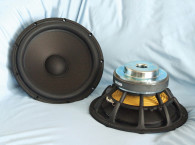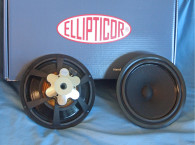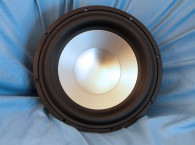


Scan-Speak’s new 28W/4878T00 10” subwoofer (see Photo 1) has a well-chosen feature set that includes a proprietary cast seven-spoke cast-aluminum frame that has minimal reflection surfaces and is completely open below the spider mounting shelf. Other features include a stiff, lightweight paper sandwich cone—further stiffened by a 3.25” convex coated woven fiber dust cap. Suspension is provided by a low-loss (high Qm) NBR surround plus a 7” diameter black flat cloth spider (damper) with the flat woven tinsel leads looping beneath the spider and soldered to a pair of gold-plated terminals.
All this is driven by a 75 mm diameter (3”) voice coil wound with round wire on a paper reinforced vented titanium former. The motor system powering the cone assembly utilizes a 25 mm thick, 180 mm diameter ferrite magnet sandwiched between an 8 mm thick front plate and a polished shaped T-yoke that incorporates a 35 mm diameter pole vent and a 20 mm high bumpout. The 28W/4878T00 incorporates the Scan-Speak patented Symmetrical Driver (SD) motor structure that includes dual copper shorting rings (Faraday shields) that reduces distortion caused by eddy currents.
I used the LinearX LMS analyzer and VIBox to measure both voltage and admittance (current). Sweeps were generated in free-air at 0.3V, 1V, 3V, 6V, 10V, 15V, and 20V. The measured Mmd that was provided by Scan-Speak (an actual physical cone assembly measurement with 50% of the surround, spider and tinsel leads removed) was used rather than a single 1 V added (delta) mass measurement, for its improved accuracy over any of the disturbance methods. It should also be noted that this multivoltage parameter test procedure includes heating the voice coil between sweeps for progressively longer periods to simulate operating temperatures at that voltage level (raising the temperature to the first and second time constants).
I further processed the 14 sine wave sweeps for each woofer and divided the voltage curves by the current curves to produce impedance curves. I generated the phase curves using the LEAP phase calculation routine, then copy/pasted the impedance magnitude and phase curves plus the associated voltage curves into the LEAP 5 Enclosure Shop software’s Guide Curve library. I used this data and the LEAP 5 LTD transducer model to calculate parameters.
Because most manufacturing data is produced using either a standard transducer model or in many cases the LEAP 4 TSL model, I also generated LEAP 4 TSL model parameters to compare with the manufacturer’s data. Figure 1 shows the 28W/4878T00’s 1 V free-air impedance plot. Table 1 compares the 28W/4878T00’s LEAP 5 LTD and LEAP 4 TSL Thiele-Small (T-S) parameter sets along with the Scan-Speak factory data.
From the comparative data shown in Table 1, you can see that all four parameter sets for the two samples were reasonably similar and correlated well with the factory data. Following my normal protocol for Test Bench testing, I used the Sample 1 LEAP 5 LTD parameters and set up two computer box simulations—one in a 0.96 ft3 Butterworth-type sealed enclosure with 50% fill material (fiberglass) and for the second example, I programmed an Extended Bass Shelf (EBS) vented enclosure in a 2.9 ft3 with 15% fill material (fiberglass) and tuned to 18.3 Hz.



Figure 2 shows the 28W/4878T00’s results in the sealed and vented EBS enclosures at 2.83 V and at a voltage level high enough to increase cone excursion to Xmax + 15% (16.1 mm). This resulted in a F3 of 42.5 Hz (-6 dB = 34.3 Hz) with a Qtc = 0.69 for the 0.96 ft3 closed box and a -3 dB for the EBS vented simulation of 29.4 Hz (-6 dB = 23 Hz). Increasing the voltage input to the simulations resulted in 113.7 dB at 48 V for the sealed enclosure simulation and 111.7 dB with a 40 V input level for the larger vented box. Figure 3 shows the 2.83 V group delay curves. Figure 4 shows the 48 V/40 V excursion curves.
Klippel analysis for the 28W/4878T00 produced the Klippel data graphs shown in Figures 5–8. Our analyzer is provided courtesy of Klippel GmbH and the testing was, as usual, performed by Patrick Turnmire, of Redrock Acoustics.

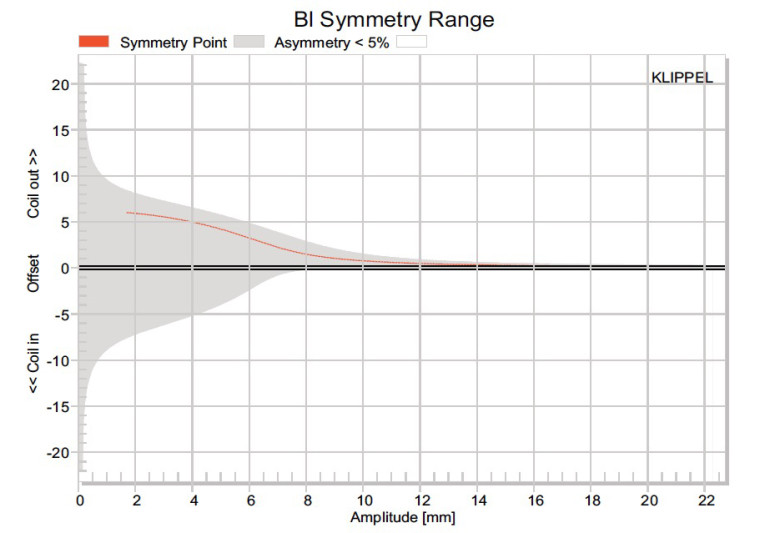


The Bl(X) curve is moderately broad and mostly symmetrical (with a bit of “tilt”) typical of a high Xmax driver (see Figure 5). Looking at the Bl symmetry curve (see Figure 6), there is a small 1.24 mm Bl coil-out (forward) offset once you reach an area of reasonable certainty (8.5 mm), decreasing to an insignificant 0.60 mm at physical 14 mm Xmax position and beyond. Figure 7 and Figure 8 show the 28W/4878T00’s Kms(X) and Kms symmetry curves.
Like the Bl curve, the Kms stiffness of compliance curve shown in Figure 8 is symmetrical, with only a minor offset. The Kms symmetry range curve exhibits a minor 1.1 mm coil-out (forward) offset at a region of high certainty (5 mm) that decreases to 0.62 mm by the 28W/4878T00 Xmax number. Displacement limiting numbers calculated by the Klippel analyzer for the 28W/4878T00 using the subwoofer criteria for Bl was XBl at 70% (Bl dropping to 70% of its maximum value) equal to 14.6 mm for the prescribed 20% distortion level (the criterion for subwoofers). For the compliance, the crossover (XC) at 50% Cms minimum was 18.5 mm, which means that for the 28W/4878T00, the Bl is the more limiting factor for getting to the 20% distortion level. However, both numbers were greater than the driver’s 14 mm physical Xmax.
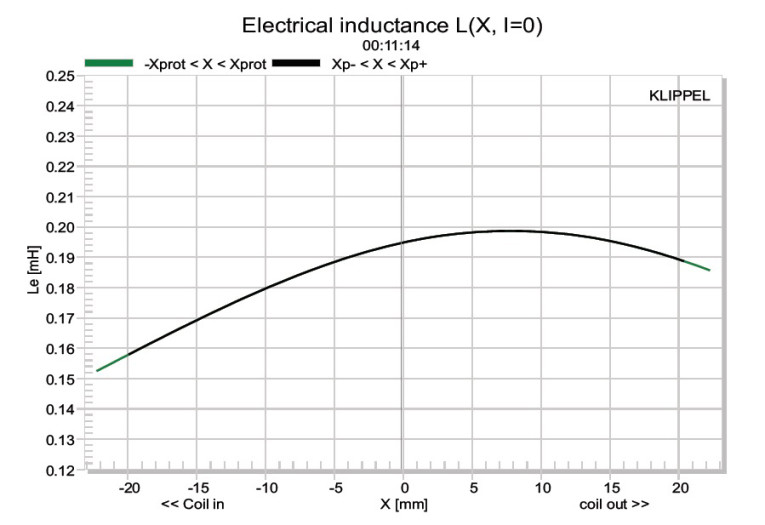
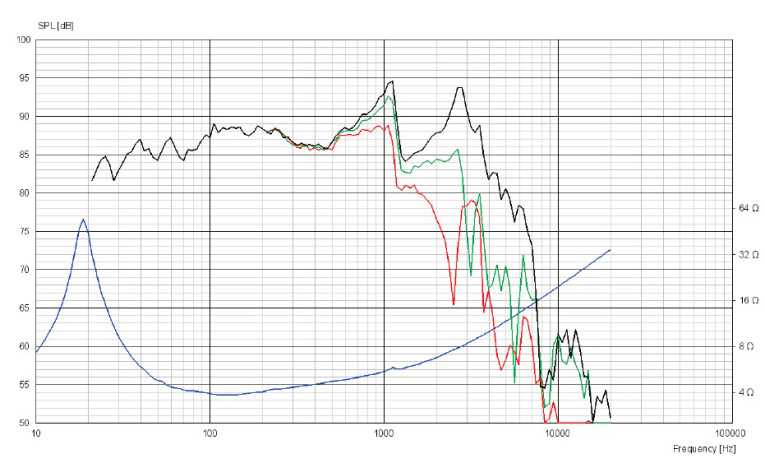
Figure 9 gives the 28W/4878T00’s inductance curve Le(X). Motor inductance will typically increase in the rear direction from the zero rest position as the voice coil covers more of pole. However, that doesn’t happen here. What we do get is lower inductance variation from full in to full out travel, which is the goal.
It’s easy to see the benefit of the copper shorting rings with inductance only varying about 0.023 mH, which is a minimal inductance change for such a large motor. As with most subwoofers, I generally do not conduct sound pressure level (SPL) testing as they operate in a range mostly below 100 Hz. However, Figure 10 shows the factory measured on-axis and 30° and 60° off-axis response, along with the free-air impedance.
Next, I used the Listen SoundCheck analyzer to perform distortion and time-domain analysis. For the distortion measurements, I set the voltage level with the driver mounted in free air and the increased voltage until it produced a 1 m SPL of 94 dB (6 V). Next, I made the distortion measurement with the microphone placed near-field about 10 cm from the dust cap (see Figure 11). Figure 1 actually includes two plots, the top graph being the standard fundamental SPL curve with the second and third harmonic curves, and the bottom graph the second and third harmonic curves plus the total harmonic distortion (THD) curve with an appropriate X-axis scale.

Interpreting the subjective value of conventional distortion curves is almost impossible. However, looking at the relationship of the second to third harmonic distortion curves is of value. Note I also did not create any SoundCheck SoundMap Time Domain CSD and STFT plots for the 28W/4878T00 for same reason that I do not generally perform SPL measurements on subwoofers.
As a consultant, I have created system designs using Scan-Speak drivers on numerous projects and have a tremendous amount of respect for this company. As you can see from this month’s explication, the 28W/4878T00 is another well-crafted and well-designed transducer from the engineers at Scan-Speak. For more information, visit www.scan-speak.dk. VC
This article was originally published in Voice Coil, September 2017.
Important Note: The original printed version of this article about the 28W/4878T00 subwoofer mentioned the reference Scan-Speak 28W/4578T00 in the title and parts of the text, and referred to the product as 28W/4748T00 in some of the captions. This was a mistake, the correct reference is the 28W/4878T00 and the online version is now corrected.




